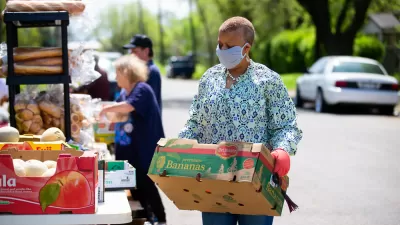As pandemic-era assistance programs expire, the rate of food insecurity for rural households is rising higher than in their urban counterparts.

“The percentage of rural households experiencing food insecurity grew by 4 points in 2022 to 15%,” as compared to a growth of 12 percent in metropolitan areas, reports Sarah Melotte for The Daily Yonder.
“The increasing gap between rural and urban food insecurity suggests that rural communities are struggling to bounce back from pandemic challenges more than their urban peers,” Melotte adds.
One aspect of growing food insecurity is the loss of free school meal programs, the cost of which can add up for a low-income family. “At the end of 2021, Congress also allowed the expiration of the expanded child tax credit. The credit cut child poverty in half during the first year of the pandemic. But new census data shows that child poverty doubled after the expansions ended.”
The article also attributes the higher rate to renewed work requirements for SNAP recipients and increases in the cost of living that “disproportionately hurt rural communities because they deal with both longer distances to grocery stores and higher fuel prices.”
FULL STORY: Food Insecurity Increased Faster in Rural Areas than Urban Ones Last Year

Study: Maui’s Plan to Convert Vacation Rentals to Long-Term Housing Could Cause Nearly $1 Billion Economic Loss
The plan would reduce visitor accommodation by 25,% resulting in 1,900 jobs lost.

North Texas Transit Leaders Tout Benefits of TOD for Growing Region
At a summit focused on transit-oriented development, policymakers discussed how North Texas’ expanded light rail system can serve as a tool for economic growth.

Why Should We Subsidize Public Transportation?
Many public transit agencies face financial stress due to rising costs, declining fare revenue, and declining subsidies. Transit advocates must provide a strong business case for increasing public transit funding.

How to Make US Trains Faster
Changes to boarding platforms and a switch to electric trains could improve U.S. passenger rail service without the added cost of high-speed rail.

Columbia’s Revitalized ‘Loop’ Is a Hub for Local Entrepreneurs
A focus on small businesses is helping a commercial corridor in Columbia, Missouri thrive.

Invasive Insect Threatens Minnesota’s Ash Forests
The Emerald Ash Borer is a rapidly spreading invasive pest threatening Minnesota’s ash trees, and homeowners are encouraged to plant diverse replacement species, avoid moving ash firewood, and monitor for signs of infestation.
Urban Design for Planners 1: Software Tools
This six-course series explores essential urban design concepts using open source software and equips planners with the tools they need to participate fully in the urban design process.
Planning for Universal Design
Learn the tools for implementing Universal Design in planning regulations.
City of Santa Clarita
Ascent Environmental
Institute for Housing and Urban Development Studies (IHS)
City of Grandview
Harvard GSD Executive Education
Toledo-Lucas County Plan Commissions
Salt Lake City
NYU Wagner Graduate School of Public Service





























